Podcast: Play in new window | Download (Duration: 17:09 — 14.9MB)
Thanks to Varmints! podcast for suggesting the dodo for this week’s topic.
And thanks to Two Clams Gaming podcast for suggesting clams as this week’s topic.
It’s two suggestions in one fun episode! Learn all about that most famous of extinct birds and all about a thing that tastes great deep-fried. (Well, okay, everything tastes great deep-fried. But you know what I mean.)
The dodo:
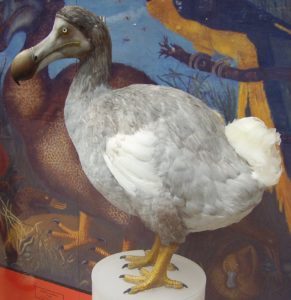
A giant clam and its algae pals:
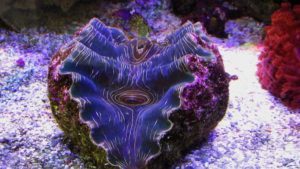
Stop, thief! Put that clam down!
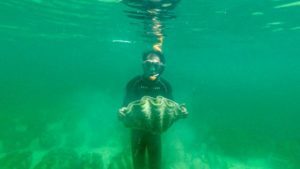
The disco clam looks as awesome as its name implies. It looks like a Muppet clam:
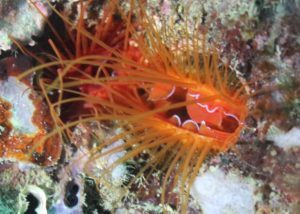
Calyptogena magnifica hanging out around a hydrothermal vent:
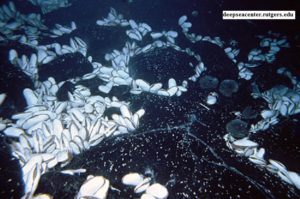
Show transcript:
Welcome to Strange Animals Podcast. I’m your host, Kate Shaw.
We’re getting backed up on suggestions, so I’m going to combine two in one episode today even though they don’t really have anything to do with each other. The first suggestion is from the podcast Varmints, a super fun podcast about animals. They want to know about the dodo. After that, we’ll go on to learn about clams. Yes, clams! Totally not anything to do with dodos, but the hosts at Two Clams Gaming suggested it. That’s another fun podcast, this one about video games—which you may have guessed. I’ll have links to both podcasts in the show notes for you to check out.
The dodo isn’t just extinct, it’s famously extinct. Dead as a dodo. That makes it difficult to research the dodo, too—type “dodo” into the search bar at Science Daily, for instance, and you get a ton of hits that have nothing to do with the actual dodo bird, like the article that says “Researchers believe they now know why the supersonic trans-Atlantic Concorde aircraft went the way of the dodo.” I don’t care. I’m here for the birds. Lots of animals and birds have gone extinct over the years, unfortunately. Why is the dodo special?
The first known sighting of a dodo was in 1598 by Dutch sailors who stopped by the island of Mauritius in the Indian Ocean. The last known sighting of a dodo was in 1662, just 64 years after those Dutch sailors noticed a weird-looking bird walking around. The dodo went extinct so quickly, and was so little known, that for a couple of centuries afterwards many people assumed it was just a sailor’s story. A big stupid bird that couldn’t fly that would walk right up to a sailor and let itself be killed? No way was that real.
But there were remains of dodos, and in the 19th century scientists gathered up what they could find and studied them. More remains were found on Mauritius. Pretty soon researchers had a pretty good idea of what had happened. The dodo had no predators on Mauritius so was able to live in a birdie garden of Eden, eating fruit and nuts, wandering around admiring the scenery, making new dodos. It grew big and happy, lost the ability to fly, and nested on the ground since almost nothing was around that might eat its eggs. Then humans showed up, happy to eat not just the eggs but the meat of any dodos they could find, although reports were that while the meat tasted pretty good, it was really tough. What the sailors didn’t eat, the animals they brought with them did, like pigs and dogs. It was a stark and clear picture of human-caused extinction, shocking to the Victorian naturalists who studied it. The dodo became a cautionary tale and early rallying cry for conservation.
We all have a mental image of what the dodo looks like just because it’s appeared in so many cartoons and children’s stories, from Alice in Wonderland to that Madagascar movie. But what did the dodo actually look like?
Well, it looked just like the cartoon versions of itself. This really was a silly-looking bird. It was big, over three feet tall, with brown or gray feathers, a floofy tuft of gray feathers as a tail, big yellow feet like a chicken’s, and a weird head. The feathers stopped around the forehead if birds had actual foreheads, making it look sort of like it was wearing a hood. Its face was bare and the bill was large, bulbous at the end with a hook, and was black, yellow, and green. The dodo looks, in fact, a lot like what you might expect pigeons to evolve into if pigeons lived on an island with no predators, and that’s exactly what happened. The dodo is closely related to pigeons and doves. Its closest living relative is the Nicobar pigeon, a large, gorgeous bird with iridescent feathers. Like other pigeons, the dodo’s feathers probably had at least some iridescence too.
The dodo wasn’t clumsy and it wasn’t necessarily fat. A lot of the drawings and paintings we have of dodos were made from badly taxidermied birds or from overfed captive birds. At least eleven live dodos were brought to Europe and Asia, some bound for menageries, some intended as pets. The last known captive dodo was sent to Japan in 1647. In the wild, the dodo was a sleek bird that could run quite fast. It may have eaten crabs and other small animals as well as roots, nuts, seeds, and fruit. The dodo was also probably pretty smart. People only thought it was dumb because it didn’t run away from sailors—but it had never had to worry about anything more dangerous than an occasional egg-stealing crab before.
The dodo wasn’t the only creature on Mauritius to die out after ships started visiting the island, either. Other birds went extinct too, like the red rail, the broad-billed parrot, the Mauritius owl, and many others. So did animals like the Mauritian giant skink, two species of giant tortoise, and the small Mauritian flying fox. Even some plants, like the palm orchid, are long gone. Worse, there were undoubtedly dozens of species that went extinct without any human ever seeing them. We’ll never know the extent of the loss.
The stuffed dodos some museums display aren’t real. All we have of real dodos are bones and one dried head. Back in the 17th century, taxidermy was pretty primitive. Skins often weren’t treated with preservatives at all, and the preservatives that were in use didn’t last very long. There aren’t any taxidermied animals from before around 1750. Bugs ate them up.
The dodo is frequently mentioned when people bring up de-extinction. That’s the term used for cloning an extinct animal or genetically modifying a living animal to closely resemble an extinct ancestor. The dodo would be a good candidate for de-extinction since its habitat still exists. The problem is that we don’t have much genetic material to draw from. But DNA sequencing gets more sophisticated every year, so fingers crossed that a hundred years from now, there might be dodos on Mauritius again.
We know a decent amount about the dodo, but one of its close relatives, the spotted green pigeon, is an utter mystery. It’s extinct too, but we only have one specimen—there used to be two, but no one knows where the second one went. For a long time researchers weren’t even sure the spotted green pigeon was a distinct species or just a Nicobar pigeon with weird-colored feathers, but in 2014, DNA testing on two of the remaining specimen’s feathers showed it was indeed a separate species. Researchers think the spotted green pigeon, the dodo, and another extinct bird, the Rodrigues solitaire, all descended from an unknown pigeon ancestor that liked to island hop. Sometimes some of those pigeons would decide they liked a particular island and would stay, ultimately evolving into birds more suited to the habitat.
Because there were no scientific studies of Mauritius and its two closest islands until the 19th century, there’s been a lot of confusion about what birds lived where before they went extinct. For a long time researchers thought there was a variety of dodo on the island of Reunion with light-colored or white plumage. The white dodo was sometimes called the solitary dodo, causing confusion with the related flightless bird, Rodriguez solitaire. The island of Rodriguez is about 300 miles east of Mauritius. In 1987 fossils of a type of ibis were found on Reunion, and in 1995 they were connected with accounts of the Reunion solitaire, a flightless white bird with black markings that went extinct around the same time as the dodo. Researchers now believe reports of the white dodo from Reunion were actually describing the Reunion solitaire, now called the Reunion ibis. No dodo remains have ever been found anywhere except on Mauritius.
If all that sounds confusing, consider that when dodos were still alive, people referred to them as everything from ostriches to penguins. And no one has any idea where the name dodo actually came from.
As far as we know, the dodo only laid one egg at a time. It probably fed its baby with crop-milk like other pigeons and doves. That’s a substance that’s formed from the protein-rich lining of both parent bird’s crops, which detaches from the crop, is regurgitated by the parent and fed to the babies. It’s not anything like mammal milk but it’s pretty neat. The only other birds known to produce something similar are flamingos and some species of penguin, although in those birds the secretion comes from the lining of the esophagus. In pigeons and doves, the parents feed the babies exclusively on crop milk for the first week of life, then start mixing in regular food that’s been softened in the parent’s crop. I suppose I should explain that the crop is a sort of extra stomach where food is stored before being digested. It allows a bird to gorge itself if it comes across a lot of food. Not all birds have a crop.
One last interesting thing about the dodo. In 1973, botanists studying Mauritius couldn’t figure out why the tambalacoque, also called the dodo tree, was dying out. Supposedly only 13 trees remained, all around 300 years old, although that number seems to be mistakenly low. While the dodo trees produced seeds, very few of them germinated. Biologist Stanley Temple suggested that the tough-shelled seeds needed to pass through the digestive tract of the dodo to germinate properly. The dodo had a powerful gizzard that it filled with small stones it swallowed, which helped grind up tough plant materials. Temple hypothesized that by passing through the gizzard, the dodo tree seeds were abraded enough to germinate. He fed some of the seeds to turkeys, which have similar gizzards, and the recovered seeds promptly germinated. Botanists now use gem polishers—and sometimes turkeys—to abrade the seeds.
[bird sound]
Until I started my research for this episode, the only thing I knew about clams was that they’re really good fried. Oh, and that they have two shells that are super common and boring when you’re beachcombing. Specifically, they’re bivalve mollusks, but they’re not the only bivalve mollusks. Scallops, oysters, and mussels are too, and some close relations include slugs, snails, and squids.
Clams live in oceans and fresh water throughout the world. They start life as microscopic larvae that drift through the ocean eating plankton for a few weeks before attaching themselves to a piece of sand, gravel, shell, or whatever. At that point they burrow into the mud or sand until they develop their own shells. The adults live most of their lives partially buried in the sand in shallow water. Clams are filter feeders, sucking in water through a tube called a siphon and straining it with tiny hair-like structures called cilia.
The smallest clams are just .1 millimeter long. The biggest clam is the giant clam that lives in the Pacific and Indian oceans. These are the ones that used to be featured in short stories about divers in peril, their arm trapped by a giant clam and their air supply running out. What to do?? Or maybe I just read some weird stuff as a kid.
The giant clam can grow over four feet across and can live for more than a hundred years. It’s the only clam that can’t close its shell completely, especially as it gets bigger. Its mantle, the inside fleshy part of its body, protrudes past the edges of the shell like big stripey clam lips. But the giant clam spends most of the day with its shell open so that sunlight reaches the algae that live inside its mantle. The algae help feed the clam.
Giant clams are edible and have the reputation as being an aphrodisiac. As a result, they’re becoming more and more endangered, especially since the biggest shells are also worth money on the black market. Who knew there was a black market for clam shells? Seriously, people will spend money on anything. The next person contemplating dropping cash for an illegally harvested giant clam, do me and the clams a favor and buy me a nice set of cymbals for my drum kit instead, okay? Fortunately, giant clams can be raised in captivity and released into the wild.
And no, divers don’t get caught and drowned by giant clams. That’s a myth.
While most pearls are made by oysters, lots of mollusks can make them, including clams. The giant clam naturally produced the largest pearl ever found. It weighs 75 pounds. The Filipino fisherman who found it kept it under his bed for ten years as a good luck charm. It’s a foot in width and over two feet in length. It’s supposed to be worth over a million dollars, but don’t think about turning to a life of crime. A few months ago, in March of 2017, ten men were arrested for illegal possession of giant clam pearls and the giant clams themselves. Book em, Danno.
Different species of mollusk produce pearls of different color. The Ko-hog clam, which is frequently made into chowders, occasionally produces a purple or lavender pearl. They’re not always very pretty—they may not have much of a lustre compared to oyster pearls, or are lumpy in shape. But when a pretty one does turn up, they can be worth a lot. In 2009, a man eating seafood stew at his birthday meal discovered a pearl in his bowl the size of a big pea, which he later sold for $16,500. I could buy, like, so many cymbals for that kind of money.
There are some weird species of clams out there. The disco clam lives in underwater caves in the Indo-Pacific Ocean. They flash brightly to scare off predators. Until a few years ago researchers assumed the lights were a type of bioluminescence, but it turns out that the flashes are caused by double-layered tissues. One of the layers is light absorbent and the other is highly reflective. The clam rolls and unrolls the tissues to flash the reflected light. The disco clam also appears to secrete noxious mucus to repel predators.
While most clams live in the shallows, there are some species that are found much deeper. In parts of the deep sea with a lot of volcanic activity, hydrothermal vents attract all kinds of marine life, including specialized clams. Calyptogena magnifica and its close relatives, which are big white clams that live around thermal vents, has no digestive organs. Instead, hydrogen-oxidizing bacteria live in its gills. The clam absorbs nutrients produced by the bacteria. Hydrothermal vents don’t last forever—they go cold as magma under the sea floor moves, and new vents will open up elsewhere. Researchers have recently discovered that some animals that live near hydrothermal vents, including clams, can also survive on sunken whale carcasses by chemically leaching energy from the oily whale bones with the help of bacteria.
One of the most popular edible types of clam is the Pacific gooeyduck. It has a relatively small shell, generally no bigger than about 8 inches long, but its siphon can be more than three feet long, with occasional record-setting individuals caught with siphons over six feet long. It’s another long-lived clam—it can live for hundreds of years. The siphon is considered a delicacy the world over, but frankly, if it’s not cut into strips and deep-fried, I don’t want to bother with eating clams. Not even if I might find a pearl.
You can find Strange Animals Podcast online at strangeanimalspodcast.com. We’re on Twitter at strangebeasties and have a facebook page at facebook.com/strangeanimalspodcast. If you have questions, comments, or suggestions for future episodes, email us at strangeanimalspodcast@gmail.com. If you like the podcast and want to help us out, give us a rating and review on iTunes or whatever platform you listen on. We also have a Patreon if you’d like to support us that way. Rewards include exclusive twice-monthly episodes and stickers.
Thanks for listening!